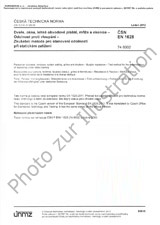Wir benötigen Ihre Einwilligung zur Verwendung der einzelnen Daten, damit Sie unter anderem Informationen zu Ihren Interessen einsehen können. Klicken Sie auf "OK", um Ihre Zustimmung zu erteilen.
ČSN EN ISO 18592 (051109)
Resistance welding - Destructive testing of welds - Method for the fatigue testing of multi-spot-welded specimens
Name übersetzen
NORM herausgegeben am 1.3.2020
Informationen über die Norm:
Bezeichnung normen: ČSN EN ISO 18592
Zeichen: 051109
Katalog-Nummer: 509051
Ausgabedatum normen: 1.3.2020
SKU: NS-984806
Zahl der Seiten: 48
Gewicht ca.: 144 g (0.32 Pfund)
Land: Tschechische technische Norm
Kategorie: Technische Normen ČSN
Kategorie - ähnliche Normen:
Die Annotation des Normtextes ČSN EN ISO 18592 (051109):
This document specifies test specimens and procedures for performing constant load amplitude fatigue tests on multi-spot-welded and multi-axial specimens in the thickness range from 0,5 mm to 5 mm at room temperature and a relative humidity of maximum 80 %. The applicability of this document to larger thicknesses can be limited by mechanical properties such as yield strength and formability of the specimen material. The thickness range for advanced high strength steels (AHSS) is generally below 3,0 mm. Greater thicknesses apply for aluminium alloys, for example.
Depending on the specimen used, it is possible from the results to evaluate the fatigue behaviour of:
- - spot welds subjected to defined uniform load distribution;
- - spot welds subjected to defined non-uniform load distribution;
- - spot welds subjected to different defined combinations of shear-, peel- and normal-tension loads; and
- - the tested specimen.
- Multi-spot specimens with which the different load distributions can be realized are the following:
a) defined uniform load distribution:
- 1) H-specimens for shear- and peel-loading, (welds subjected to uniform shear or peel loading transverse to the joint line);
- 2) single- and double-hat specimens subjected to four-point bending (spot welds subjected to uniform shear load in the direction of the row of welds);
- 3) double-disc specimen under torsion (spot welds subjected to uniform shear load);
- 4) double-disc specimen under tensile load (spot welds subjected to uniform peel load);
- 5) double-disc specimen under combined torsion and tensile loading;
- 6) flat multi-spot specimens using defined grips;
b) defined non-uniform load distribution:
- 1) H-specimens with modified grips;
- 2) modified H-specimens with standard grips;
- 3) modified H-specimens with modified grips;
- 4) flat multi-spot specimens with modified grips;
- 5) modified multi-spot flat specimens with standard grips;
- 6) modified multi-spot flat specimens with modified grips;
c) defined combinations of shear-, peel- and normal-tension loads:
- 1) the KS-2 specimen;
- 2) the double disc specimen;
- d) spot welds subjected to undefined non-uniform load distribution - single-hat, double-hat and similar closed hollow sections under torsion, 3-point bending and/or internal pressure.
- - The specimens and tests referred to under c) above are not dealt with further in this document, because the results obtained with these specimens are specific to the components as tested and may not be generalized or used for deriving data pertaining to the load-carrying behaviour of the welds. Results obtained with such tests are suitable for comparing the mechanical properties of the tested components with those of similar components tested in the same manner. These tests are, however, not suitable for evaluating or comparing the load-carrying properties of the welds.
- - The test results of the fatigue tests obtained with component like specimens are suitable for deriving criteria for the selection of materials and thickness combinations for structures and components subjected to cyclic loading. This statement is especially relevant for results obtained with specimens with boundary conditions, i.e. a local stiffness similar to that of the structure in question. The results of a fatigue test are suitable for direct application to design only when the loading conditions in service and the stiffness of the design in the joint area are identical.
NOTE - Specimens are modified to take into consideration constraints or specific demands posed by design, e.g. smaller than standard overlap, smaller or larger than standard nugget diameter, and specific load distribution, thus enhancing the value of the test results for the design engineer
Normansicht ČSN EN ISO 18592 (051109)
Empfehlungen:
Aktualisierung der technischen Normen
Wollen Sie sich sicher sein, dass Sie nur die gültigen technischen Normen verwenden?
Wir bieten Ihnen eine Lösung, die Ihnen eine Monatsübersicht über die Aktualität der von Ihnen angewandten Normen sicher stellt.
Brauchen Sie mehr Informationen? Sehen Sie sich diese Seite an.




 Cookies
Cookies
